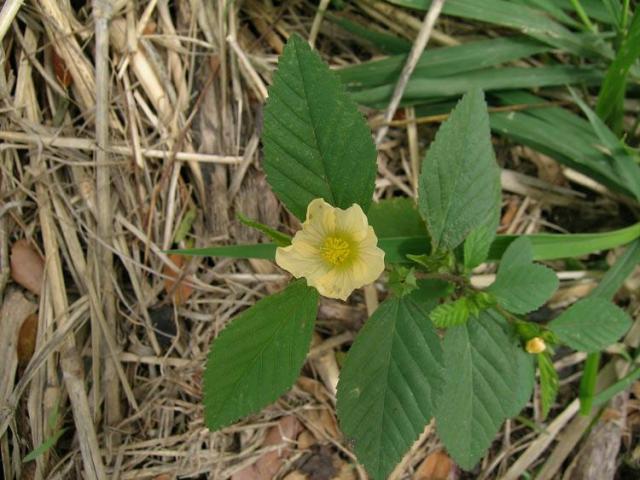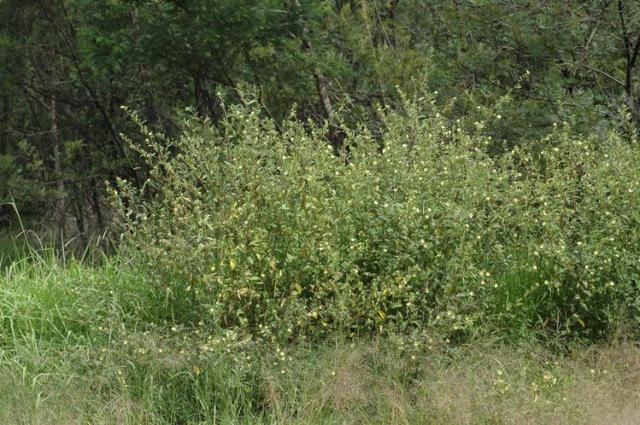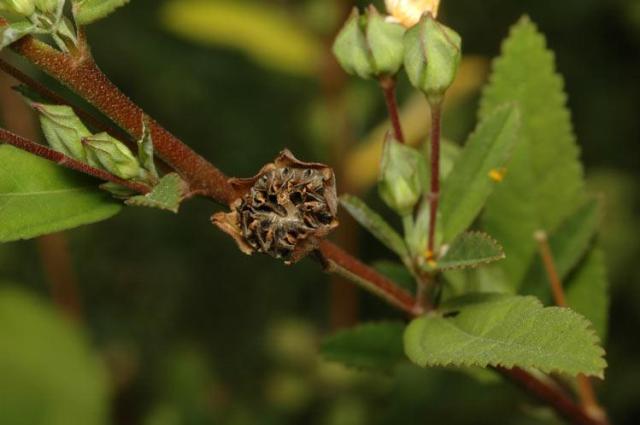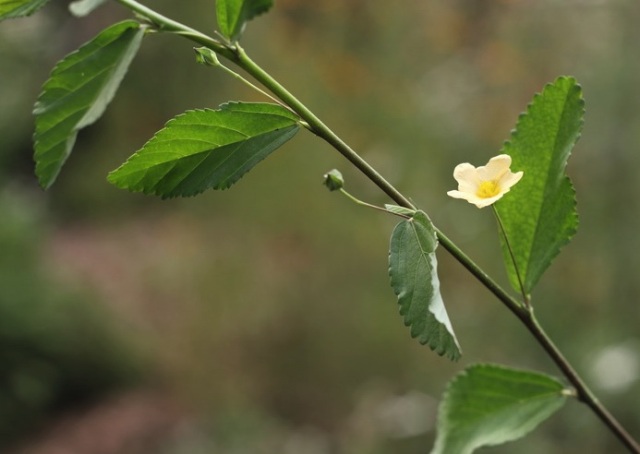And one of the most effective antibiotics on the planet – Grows Wild Here
Australian National Botanic Gardens



http://www.eattheweeds.com/sida-wireweed/

For years I was pulling up this amazing woody perennial plant from my garden. Until one day I identified it and became a convert. It still takes over part of my garden every year so I have had to harvest it or be overwhelmed because it likes to grow in pathways. But it self seeds so well I don’t worry too much, I just don’t harvest all of the plants in the areas it grows (many).
Like my herbal women friends in the Wise Woman movement, where they say if there is a problem with your body, nature will provide the plant to handle it within a short distance from your home. Of course this might be harder in a big city, but out here in the foothills of the Appalachian Blue Mountains, it is really true. So, when a plant keeps showing up, I pay attention. Nature is trying to help me or someone I love.
When I first was introduced I discovered this plant is one of the strongest and most effective antibiotics in the world. Sida has a number of varieties all with similar medicinal properties but the one that grows wild here is the rhombifolia variety. It has a lovely little yellow flower in the summer, which turns into a little seed pod with small black seeds. It grows about 3’ tall and wide, in profusion usually.
The stems are tough and are used to make brooms in various places. The bark makes a lovely white fiber used to make cord, rope, fish nets, and fine thread. The leaves are edible as a pot herb. And it makes a nice tea and delicious alcoholic tincture. So, in a few words, it’s highly beneficial.
But it has been used traditionally around the world as medicine. It shows up in Ayervedic (India’s traditional medicinal system), Traditional Chinese Medicine, and even the early Eclectic physicians of this country considered it valuable as medicine.
So, in the spirit of loving our planet and the plants on it, I thought I’d share what it can do. I didn’t pull these plants entirely before I learned of its bountiful gifts but enough to know I had no clue. So, being clueless in this case was reversed happily. The more I study this gem, the more regard I pay it.
So, once you find a source of it growing or can acquire it, here is what you can do DIY to benefit from it in so many ways.
Probably the best medicinal preparation of it using the whole plant is to make a double extraction tincture of it. Pull up the whole thing root and all. Clean the roots well, finely cut up the stems, leaves, flowers roots and all – or seeds if it has gone that far in the season. Then cover with acidic water (you don’t want it to be alkaline or neutral because the chemicals in it are released only in an acidic environment. You could add some vinegar because it likes pH between 1 and 6 – very acidic). Decoct (i.e. simmer in pure water) for several hours, cool, strain, measure the liquid. Replace the plant matter and add the same amount of grain alcohol (I would use Everclear or organically grown and prepared moonshine) as close to 100% ethanol as possible. Then cap it tightly, label, and shake it daily for 4 to 6 weeks. Then strain, bottle in colored glass and label it, and you have your double extracted tincture. This has been advised to take 20 to 40 drops up to 4x a day. More if you are fighting a gram negative bacteria.
Or you can make a tea with it, using acidic water. 1-2 tsp of the powdered leaves in 6 oz. water steeped 15 minutes. For prevention 1-2 cups/day. If fighting an infection up to 10 cups a day. For an eye infection, 1-3 drops in the eyes when cool. 3-6 x day. A cold extraction works but is not nearly as effective as a hot infusion. Because the medicinal components are alkaloids, you must use an acidic water to remove the medicine from the plant matter.
A powder of the whole plant (cleaned well) cut up and dehydrated then powdered also has many uses topically to treat a bacterial infected skin such as septic wound or eczema by liberally sprinkling on the affected areas.
The powder can be put in capsules for internal use. As a preventative for bacterial infections (or virus, protozoal infection, Candida, and the many other things mentioned below), 3 “OO” sized capsules 3x day. If acute infection up to 30 capsules a day or 1-3 Tbs. powder in water or juice.
Poultices of the leaves, roots, or whole plant can be applied to snake bites, particularly the kind of snake whose venom destroys blood cells. It is a drawing herb regardless, helping to bring out poisons. The poultices can be used for sores and boils, itching skin, and infected wounds. It also draws poison from scorpion stings and other stinging insects.
A poultice of the whole plant also treats headaches, boils, cramps, rheumatism, tooth aches, chapped lips and pimples. A poultice preparation of grease and sugar softens abscess and releases pus.
According to my research, Sida r. even handles systemic resistant Staph infections. The tincture is then used. In dosages of ½ tsp to 1Tbs. 3-6 x a day (high dosage). It is suggested not to take this high amounts for more than 60 days running but that is usually sufficient.
The list of physical conditions is long and amazing. From colds and flu to Diabetes, E-coli, ulcers, Tuberculosis, Lyme disease, Herpes, blood cancers, bronchitis, sepsis in wounds, and Malaria just to name a few. It is a pain reliever; it can be more effective than even the latest antibiotic pharmaceuticals without damage to the host (people or animals) including those that treat gram positive and negative bacterial strains. It even handles the most resistant to antibiotic strains, including those that people pick up in hospitals. It helps and protects blood, the liver, the skin, the nervous system, the digestive system; just about every part of the body has some benefit from it.
It is an immune booster and ‘adaptogenic’ i.e. it helps to balance over or under conditions in the body or where there is an imbalance of any kind.
It brings down a fever. It’s a pain killer. It lowers blood sugar for diabetics or hypoglycemics. It knocks out free radicals which cause mutations in cells and other kinds of havoc, aka ‘antioxidant’. It protects the liver and helps to regenerate it, and handles jaundice. It brings down inflammation in joints, and other parts of the body. After a heart attack, the strong antioxidants in it help to heal the heart tissue. It protects the nerves and is used for depression and other nervous system disorders. It handles diarrhea and dysentery. A paste of the whole plant treats indigestion.
The leaves are a diuretic, i.e. it makes the body pee more, flushing out toxins and freeing the kidneys. It treats kidney stones as well. A juice of the leaves mixed with vinegar is anti-inflammatory and helps with digestive problems.
The yellow leaves eaten with wild ginger eases labor for women.
A paste of the roots is applied to boils.
It’s a powerful anti-parasitic expelling worms and other internal parasites for both people and animals (NOT GOATS), treating flat worms, flukes, tape worms, and round worms. It not only kills bacteria but also amoebas, Candida, illness causing microbes, protozoas, aspergillis, a long list of kinds of bacterial and amoeba infections, and virus. It treats skin rashes like impetigo and eczema.
And because it is considered a ‘tonic’ herb, unless being used in very high dosages for specific treatment, it can be used long term and uninterrupted, being considered something that is ongoing and that tones the body. Unlike most antibiotic plants, which usually only handle ‘acute’ short term problems, this is OK to continue using.
Being edible, the leaves used as food with a very high protein content (16-25% depending on how it’s grown) it is an excellent food source and can be used as a main protein for the diet.
So, if you need seeds, contact me. I’ll send some to you for a small fee. But realizing it can be invasive if not controlled, give it a specific location with plenty of room to grow. The good news is that once it establishes, you will have an almost endless supply of medicine as well as food and fiber. Or if grown in a pot, collect the seeds when late summer rolls around. It’s pretty when in bloom, with its little yellow flowers. It will die out in winter, but can be pruned (harvested) down to the ground and return in the spring. I prefer to harvest it when it is still in bloom for the many uses I make of it.
In Summary, this is one of those treasure of the plant world. I hope it helps you.
Diann Dirks 8-19-19
Here are some of the related sites which contain a lot more information. Worth reading over if this is of interest to you.
http://tropical.theferns.info/viewtropical.php?id=Sida+rhombifolia
http://tipsdiscover.com/health/systemic-herbal-antibiotics-sida/
http://www.eattheweeds.com/sida-wireweed/
https://uses.plantnet-project.org/en/Sida_rhombifolia_(PROTA)
http://www.db.weedyconnection.com/paddys-lucerne-sida-rhombifolia/
https://herbpathy.com/Uses-and-Benefits-of-Sida-Rhombifolia-Cid4563
https://www.tandfonline.com/doi/full/10.1080/13880209.2017.1285322
https://en.wikipedia.org/wiki/Sida_cordifolia (Cordifolia like Rhombifolia are related and share many of the same medicinal properties)

I’m so thrilled to find this Sida Rhombifolia all over my property!
Like you, I savagely pulled it up, not an easy feat!
Today, while looking for eggs in this patch of 12-18” tall “weeds”, I thought, “what if this weed I’m pulling is edible or medicinal”
So I used my plant identifying app and lo and behold, it is!!
I’m happy to have found your article, just in time as it is late summer and I would have either mowed it or left it to die for the winter!
No!! I will start harvesting it starting tomorrow! I have thousands all around me!
I suppose I should just let them dry for now?
It is a woody perennial here and can be harvested leaf and stem. You can double extract it – vodka first 4 to 6 weeks, then decoct it for long lasting use.
Glad it helped. When I was doing the research one of the things it said on one site is that it’s such a powerful antibiotic it handles MRSA. I have made a tincture of it, but found not to use it for just ordinary things I use plant medicine antibiotics for. I think of it as a cannon to handle a flea otherwise. Check out the other plant medicine articles I have in the archives of the blog site. I have written many.
Best regards, Diann Dirks
I’m a novice at this and I have questions! Is the plant put back in the water and alcohol added to both? Do you save the water and make a second batch with alcohol? If the latter, what is the difference between uses of the two?
Hi Becki, I’m not an expert on this particular magical herb. I just make an alcohol tincture with it. If you want to do a double extract to further power it up, do so. Make your tincture with alcohol first, then save the marc (solids) and do a decoction (simmer in water) next for a few hours. Then blend the alcohol and water together. That’s a ‘traditional medicinal approach’. It isn’t rocket science. Do some research on your own before taking anything.
Thank you. I’m taking some herbal courses now and found this “by chance” on the property a while back. I thought that’s what it meant but wanted to be sure. Thanks again.
I have read that the plant has natural ephedrine, does drinking a tea make you jumpy at all, not wanting that. Thank you.
I’m sorry but I don’t know which plant or article you are referring to. Please PM me for the particulars on FB as Georgia Dirks. I’ll see what I can do to answer your question.